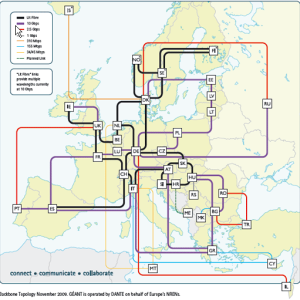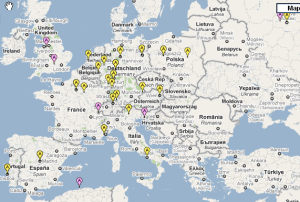We looked at plots of RTT vs Distance for pairs of Landmarks within 25ms and 1000km radii for Europe and N. America. Typically a formula of the form distance = alpha * RTT is used to derive the distance from the measured RTT. Typical values of alpha are 40 km/ms. When we measured the RTTs between landmarks of known location and derived the values of alpha, Europe seemed better behaved. We looked at the network topology for the major Academic and Research (A&R) networks in N. America, i.e. Internet2, ESnet and Canarie. They are shown below.
...
GEANT | European landmarks |
|---|---|
| |
Our initial results have showed an important insight about the intra regional connectivity of both regions. Our initial resultsdepict better depict better (less variability in alpha, and the density of landmarks (i.e. landmarks/sq km), correlation between RTT and distance) intra regional connectivity in Europe than in North America. Both North America and Europe have many n*Gigabits links connecting one state to another in N.America or one country to another in Europe. But we want We wish to see the state of connectivity of connecitivity landmarks within a few hundred miles radius around each landmark. Because in Geolocation the last mile network is also very important in improving the accuracy of the techniquetarget landmark since these are the landmarks that are most likely to be used in the eventual algorithm.
In our analysis first we calculated the correlation coefficient for all landmarks within 1000 KM km (620 miles) and 25 msec. radii (assuming an alpha of 40 km/ms) around them. We wanted to see the last few miles effect interms of distance as well delay. Below are the two graphs:
...
There are two series in each graph, white balls represent the Correlation coefficient and red balls represent the number of target landmark available within radii the chosen radius of each landmark . Size (100km or 25ms). The size of the ball represent the standard deviation of delay associated with each landmark and X-axis represents the ID of the landmark or simply the row number of the spread sheet of raw data. You can find spread sheets of 1000KM_Radius and 25MS_Radius correlation_coefficient_1000km_radius.xlsx and Correlation_Coefficient_25MS_Radius.xlsx(25MS file has the column names). Left The left-hand (Y-axis) is the Correlation coefficient value and right-hand Y-axis is the number of landmarks within radiithe radius. As you can clearly see the trend of number of adjascent adjacent landmarks and correlation coefficient are both high for the whole of Europe but they are dispursed thourghout more dispersed thoughout North America. These results contradicts contradict the perception of very good connectivity inside North America. SoThus, we decided to do further testing of this finding.
We then took the raw data of some landmark from Europe and North America again within a radii of 1000 KM and kmand 25 MS ms and plotted delay to distance graphs, we see a similar trend. Below are some sample graphs.
...
All these graphs have delay on X-axis and distance on X-axis and in all graphs with filtered caption we have applied the median filter on the values based upon delay. This was just to see the impact of removing the sensitivity to outliers. In this case outliers are those delay values which are not following the trend. E.g. if there are three distance values 400,500,600,700 and their corresponding delay values 10,12,50,17. Here 50 is clearly an outlier. As you can observe a linear increasing trend in European landmarks which is almose absent in North American nodes. This again is depicting a similar observation that Europe has more efficient and direct last mile links in contrast to North America. Raw data is available here, Nashville_NA.rar,Atlanta_NA.rar,Paris_France.rar,Darmstadt_Germany.rar.
...

